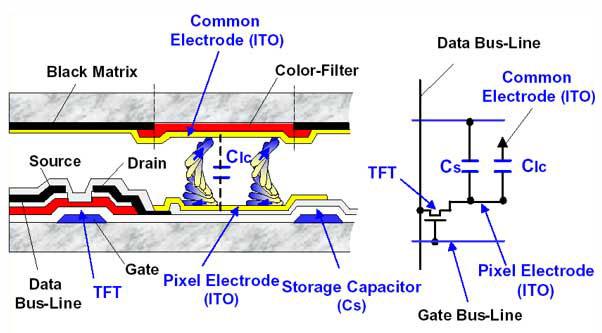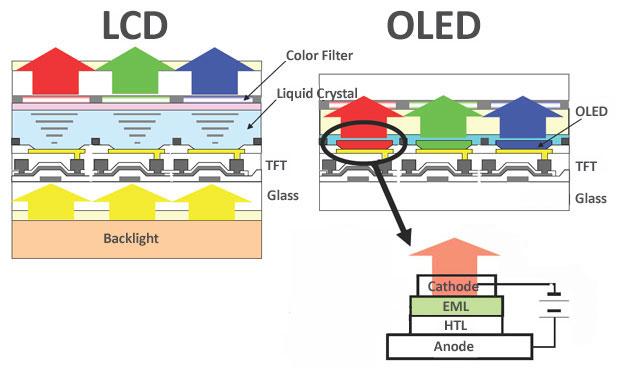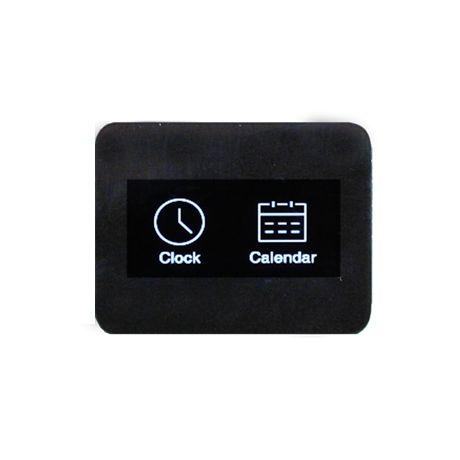Are colour OLED displays ready to offer a better alternative to TFT-LCDs, and where do today’s state-of-the-art TFT-LCDs remain strong? We all know that colour graphical display can seriously enhance the user experience your application will deliver. So let's re-cap on the advantages both TFT and OLED technology offer.
TFT-LCD: Principles, Performance, and Improvements
TFT-LCD maturity means competitive prices, good quality and reliability and available in a wide range of sizes - typically 1-21" for industrial embedded applications.
Operating principle: in similar ways to a monochrome STN, twisted liquid-crystal columns create waveguides to direct light from the display backlight through polarising filters. An electric field applied across ITO electrodes changes the crystal alignment to prevent the light passing and make specific locations appear dark. Unlike STN, however, the TFT-LCD contains red, green and blue filters; a thin-film transistor embedded in every sub-pixel modulates the light intensity to mix the desired colour. TFT-LCDs can display millions of colours, and response times can be fast enough to support full-frame-rate video or smooth animations.

Figure 1: Basic elements of a TN-TFT cell
Performance: Standard TFT-LCDs do have some limitations, however. Contrast can be limited, and colour-inversion can be perceived at extreme viewing angles. Typical contrast ratio is about 400:1 with viewing angles of L70/R70/T70/B60.
Improvements: IPS (In-Plane Switching), aka Super-TFT, displays arrived to overcome these drawbacks. In IPS, changes in crystal orientation happen in the same plane as the glass sheets that constitute the display. Pixels are dark in the off state instead of in the on state, which enables the display to appear true back when powered down. Contrast and colour fidelity are improved, and also more consistent, even at wider viewing angles than a standard TFT-LCD can manage. What’s more, there are no distracting bright-pixel defects, which can occur when a transistor fails in a conventional TFT-LCD.
The OLED Alternative
Sleek, Efficient Design: A Organic LED (OLED) displays can be made lighter and thinner than conventional or Super TFT, partly because no backlight is required. No backlight means they also consume less power, which has been the key to their success in the premium smartphone sector and is also driving adoption in mobile industrial and medical applications - such as wearable medical monitors, tele-health equipment, cordless industrial panels, and mobile robotics.

Figure 2: TN-TFT cell structure compared with OLED
Because equipment designers don’t have to be so parsimonious with power, the display can remain active for longer instead of having to be powered down as quickly as possible to conserve battery energy. Hence, they can be ready to use immediately without needing time for the display to wake up.
Bright and Beautiful: Their light weight and low profile allow OLED displays to be fixed to the surface of an enclosure, even if the surface is curved. This is easier and more economical than designing an aperture and making provision for mounting a TFT-LCD. The wider temperature range of OLEDs also makes them a robust choice for industrial applications or use outdoors.
Passive-Matrix OLED (PMOLED) displays can be monochrome or – with the inclusion of RGB sub-pixels -colour. On the other hand, PMOLEDs can suffer from limited frame rates at larger displays sizes, so Active-Matrix (AMOLED) technology introduces a thin-film transistor per pixel that allows each to remain turned on for as long as needed. An AMOLED display can be the best choice if a large, bright colour display is required.
To Summarise:
Going the TFT-LCD route, especially given the flexibility to choose standard or IPS/Super-TFT, provides a wide choice of displays that are cost-effective, readily available in numerous sizes, and easily capable of displaying full-frame-rate video and smooth animations.
On the other hand, AMOLED displays can deliver superior optical performance and wider viewing angles, with lower power consumption, reduced weight, and the engineering and aesthetic advantages of the extremely thin and flexible substrate.





